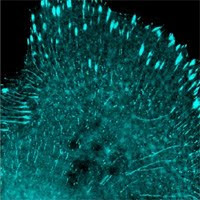http://blog.allelebiotech.com/2013/04/the-development-of-mneongreen/
This week our most recent publication, “A bright monomeric green
fluorescent protein derived from Branchiostoma lanceolatum” will be
published in Nature Methods. It has already been viewable online for
some time now, here is a link.
We believe this new protein possesses a great deal of potential to
advance the imaging fields through enhanced fluorescent microscopy.
mNeonGreen enables numerous super resolution imaging techniques and
allows for greater clarity and insight into one’s research. As a result
of this we are taking a new approach at Allele for distribution of this
protein, and here we will describe the history of the protein and some
of the factors that led us down this path.
mNeonGreen was developed by Dr. Nathan Shaner at Allele Biotechnology
and the Scintillon Institute through the directed evolution of a
yellow fluorescent protein we offer called LanYFP. LanYFP is a super
bright yellow fluorescent protein derived from the Lancelet fish
species, characterized by its very high quantum yield, however, in its
native state LanYFP is tetrameric. Dr. Shaner was able to monomerize
the protein and enhance a number of beneficial properties such as
photostability and maturation time. The result is a protein that
performs very well in a number of applications, but is also backwards
compatible with and equipment for GFP imaging.
Upon publication there was a question of how distribution should be
structured. How would we make this protein available to researchers in a
simple manner was a very difficult challenge. We also relied heavily
on Dr. Shaner’s knowledge and experience in these matters, as he related
his experiences to us from his time in Roger Tsien’s lab at UCSD. When
the mFruits was published their lab was inundated with requests. The
average waiting period was 3 months to receive a protein and they
required a dedicated research technician to handle this process.
Eventually the mFruits from the Tsien lab were almost exclusively
offered through Clontech. Thus we decided that Allele Biotechnology
would handle the protein distribution and take a commercial approach to
drastically decrease the turnaround time. The next challenge we faced
was how to charge for this protein. Due to the cost of developing this
protein, which was fully funded by Allele, there is a necessity to
recoup our investment and ideally justify further development of
research tools, but we also understand the budget constraints every lab
now faces. From this line of thinking we conceived our group licensing
model; we wanted to limit the charge to $100 per lab. The way this is
fiscally justifiable is having every lab in a department or site license
the protein at this charge, including access to all related plasmids
made by us as well as those generated by other licensed users (Click here for our licensing page).
The benefit we see to this is that the protein is licensed for full
use at a low cost, and collaboration amongst ones colleagues is not only
permissible, it’s encouraged. We saw this as a win-win situation. We
would recoup our cost and invest in further fluorescent protein
research, and our protein costs would not be a barrier to research and
innovation.
The granting of a license to use but not distribute material is not
unique to commercial sources. Although academic material transfer
agreements typically contain specific language forbidding distribution
of received material beyond the recipient laboratory, some researchers
choose to disregard these provisions. Unfortunately through this action
they are disrespecting the intellectual property rights of the original
researchers as well as violating the terms of the legal contract they
signed in order to receive the material. We believe most researchers
choose to respect the great deal of effort that goes into the creation
of research tools for biology and do not distribute any material
received from other labs without their express permission. However for a
company that funds its own basic research our focus is often on the
former example rather than the latter. We believe that this focus
artificially drives up the costs of licensing a fluorescent protein and
obtaining the plasmid, thus we have chosen to believe researchers will
respect our intellectual property as long as we are reasonable in our
distribution which is something we have truly striven for.
Additionally we believe the broad-range usage of a superior, new
generation FP is an opportunity to advocate newer technologies that can
be enabled by mNeonGreen, together with a number of Allele’s other
fluorescent proteins (such as the photoconvertible mClavGR2, and
mMaple). These new imaging technologies are called super resolution
imaging (MRI). They provide researchers with a much finer resolution of
cellular structures, protein molecule localizations, and
protein-protein interaction information. We have started the
construction of a dedicated webpage to provide early adopters with
practical and simple guidance, click here to visit our super resolution imaging portal.
Wednesday, May 1, 2013
The Development of mNeonGreen
Labels:
cell imaging,
fluorescent protein,
FP,
GFP,
mNeonGreen,
Superresolution
Subscribe to:
Post Comments (Atom)





No comments:
Post a Comment